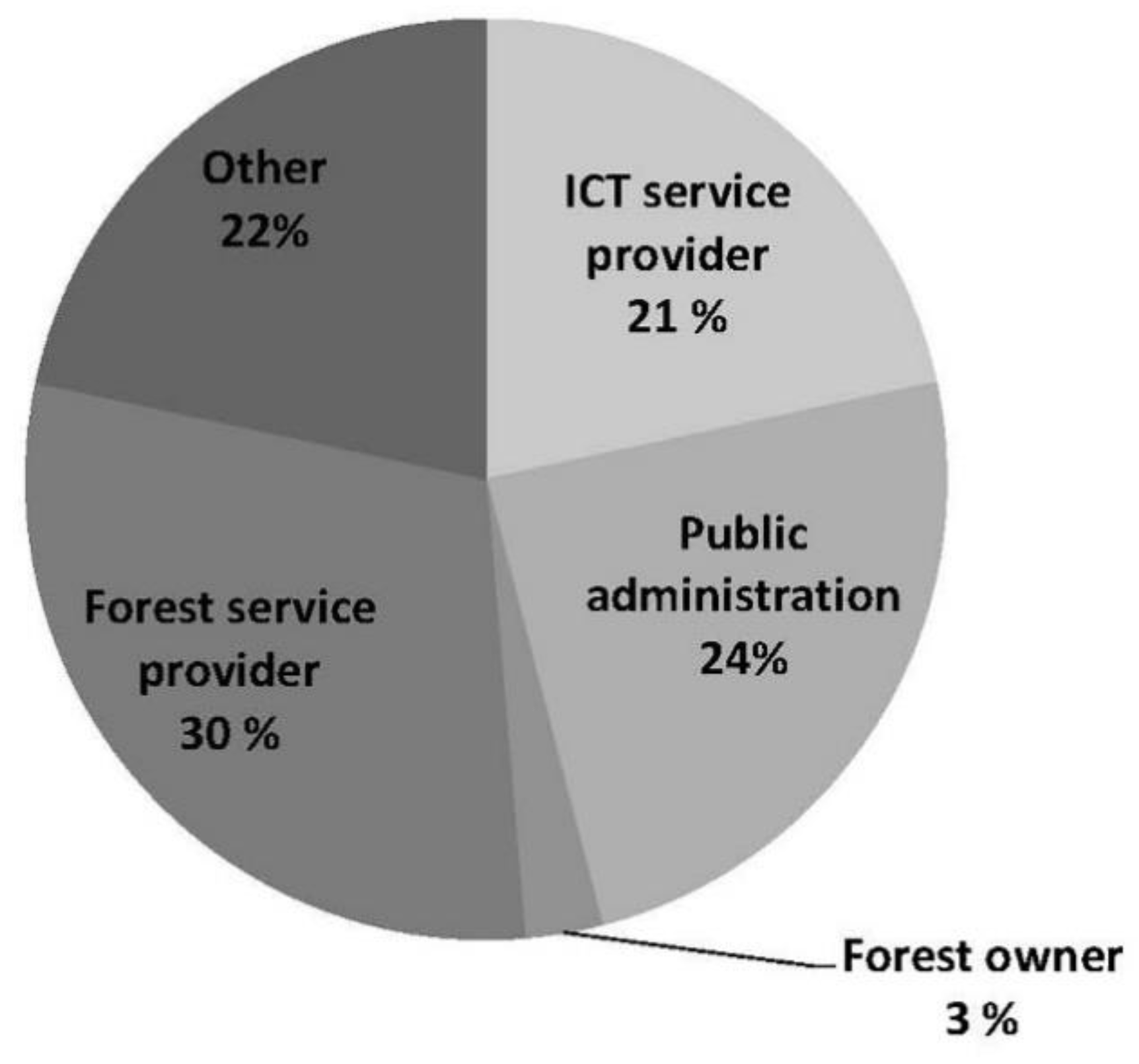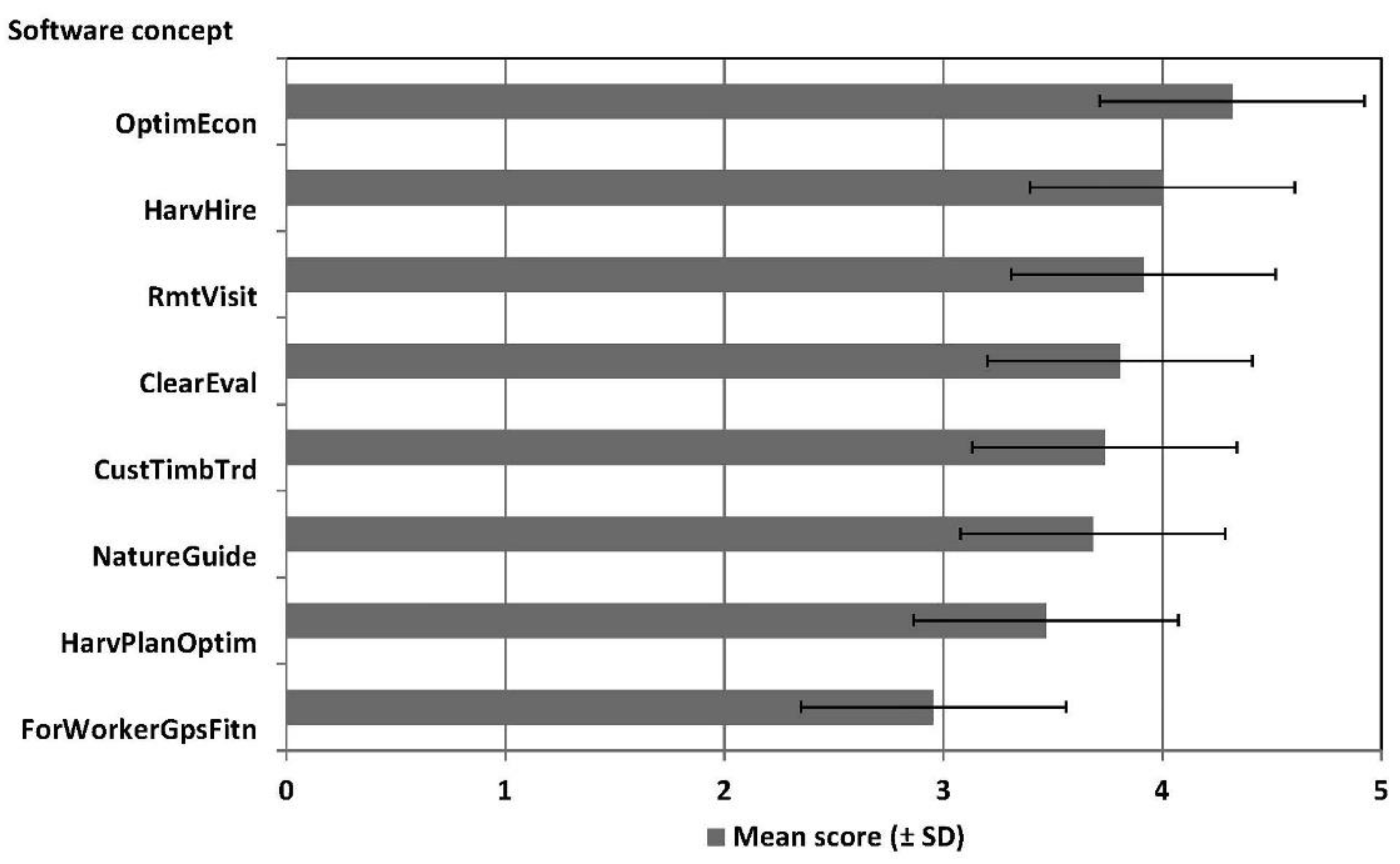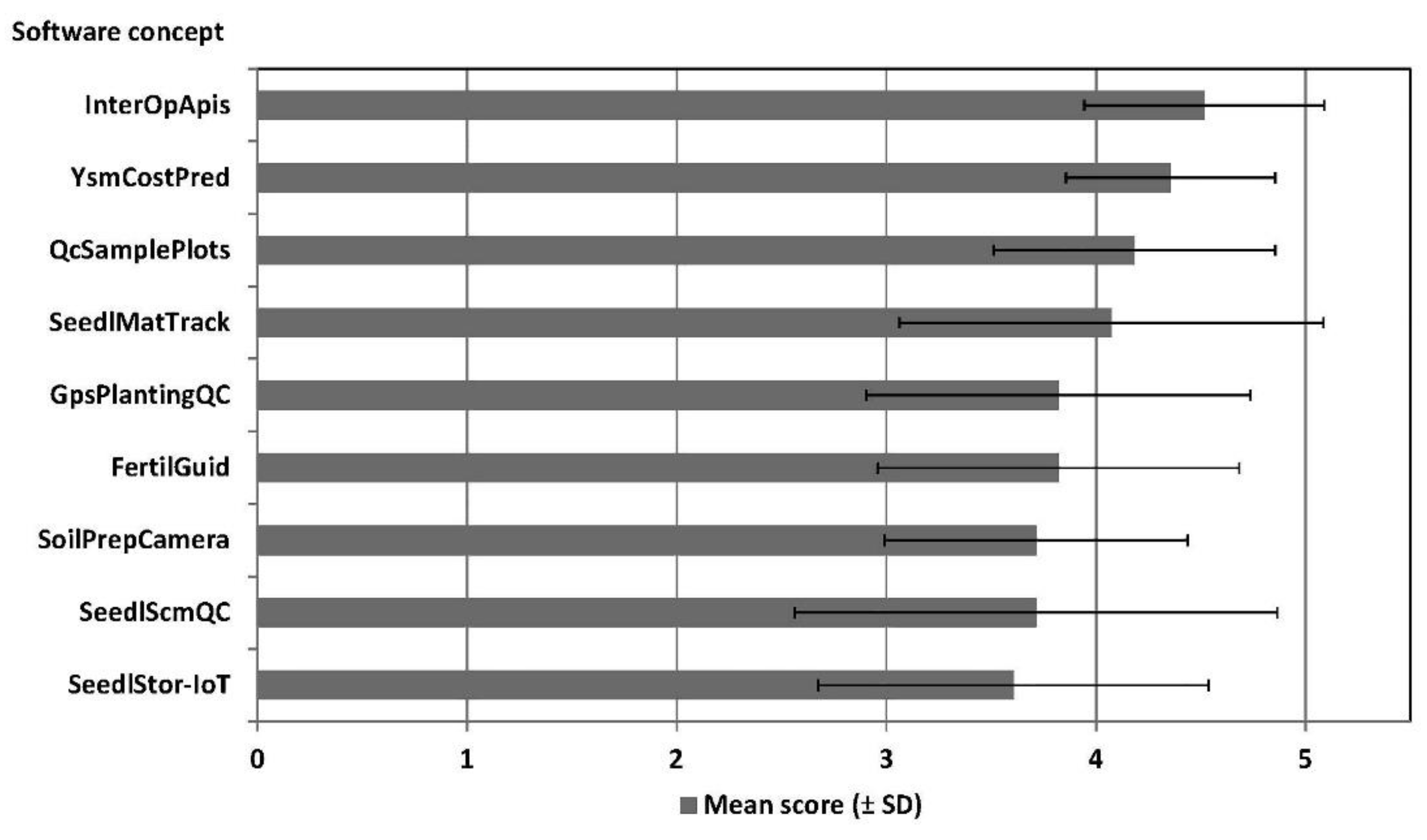Digital Transformation of Forest Services in Finland—A Case Study for Improving Business Processes
Abstract
1. Introduction
2. Materials and Methods
2.1. Research Process from Conceptual Modelling to Software Concepts
2.1.1. Forest Service Marketing
2.1.2. Forest Property Management and Timber Procurement Services
2.1.3. Silvicultural and Forest Improvement Services
2.2. Workshop for the Co-Creation and Evaluation of the Software Concepts
3. Results
3.1. Forest Property Management and Timber Procurement Services
3.2. Silvicultural and Forest Improvement Services
4. Discussion
Author Contributions
Funding
Acknowledgments
Conflicts of Interest
References
- Manyika, J.; Chui, M.; Groves, P.; Farrell, D.; Van Kuiken, S.; Doshi, E. Open Data: Unlocking Innovation and Performance with Liquid Information; McKinsey Global Institute Report; Global Institute: San Francisco, CA, USA, 2013; 103p, Available online: https://www.mckinsey.com/business-functions/mckinsey-digital/our-insights/open-data-unlocking-innovation-and-performance-with-liquid-information# (accessed on 13 November 2019).
- Kauhanen-Simanainen, A.; Suurhasko, M. Avoimesta Datasta Innovatiiviseen Tiedon Hyödyntämiseen: Avoimen Tiedon Ohjelman 2013–2015 Loppuraportti; Ministry of Finance Publications: Helsinki, Finland, 2015; Volume 31, pp. 1–33. Available online: https://vm.fi/julkaisu?pubid=6902 (accessed on 14 November 2019). (In Finnish)
- Koski, H. The Impact of Open Data—A Preliminary Study; Ministry of Finance Publications: Helsinki, Finland, 2015; Volume 15b, pp. 1–27. Available online: https://vm.fi/julkaisu?pubid=5202 (accessed on 14 November 2019).
- Herala, A. Benefits from Open Data: Barriers to Supply and Demand of Open Data in Private Organizations. Ph.D. Thesis, Acta Universitatis Lappeenrantaensis, Lappeenranta, Finland, 2018. Volume 809. pp. 1–66. Available online: http://urn.fi/URN:ISBN:978-952-335-262-9 (accessed on 11 February 2019).
- Tomppo, E. Multi-source national forest inventory of Finland. In Proceedings of the Ilvessalo Symposium on National Forest Inventories, Helsinki, Finland, 17–21 August 1992; pp. 52–60. Available online: http://urn.fi/URN:ISBN:951-40-1267-4 (accessed on 14 November 2019).
- Tomppo, E.; Heikkinen, J.; Henttonen, H.; Ihalainen, A.; Katila, M.; Mäkelä, H.; Tuomainen, T.; Vainikainen, N. Designing and Conducting a Forest Inventory—Case: 9th National Forest Inventory of Finland; Springer: Berlin/Heidelberg, Germany, 2011; Volume 22, pp. 1–270. [Google Scholar] [CrossRef]
- Yksityismetsien Metsävaratieto, Suomen Metsäkeskus. 2018. Available online: https://www.metsakeskus.fi/yksityismetsien-metsavaratieto (accessed on 21 November 2019). (In Finnish).
- Kangas, A.; Packalen, T. Metsävaratieto metsäalan toimijoiden päätöksenteossa—Käyttötilanteet ja hyötyyn vaikuttavat tekijät. Metsätieteen Aikakauskirja 2018, 10031, 1–14. [Google Scholar] [CrossRef]
- Hannus, J. Prosessijohtaminen: Ydinprosessien Uudistaminen ja Yritysten Suorituskyky, 5th ed.; HM & V Research: Jyväskylä, Finland, 1994; 368p. [Google Scholar]
- Kettunen, J. The forest cluster and Society. Water Sci. Technol. 1999, 40, 1–3. [Google Scholar] [CrossRef]
- Czabke, J.; Hansen, E.; Doolen, T. A multisite field study of lean thinking in U.S. and German secondary wood products manufacturers. For. Prod. J. 2008, 58, 77–85. [Google Scholar]
- Vergara, F.; Palma, C.; Nelson, J. Modeling lean and agile approaches—A western Canadian forest company case study. Forests 2018, 9, 529. [Google Scholar] [CrossRef]
- Womack, J.; Jones, D.; Roos, D. The Machine That Changed the World; Rawson Associates: New York, NY, USA, 1990; 323p. [Google Scholar]
- Womack, J.; Jones, D. Lean Thinking—Banish Waste and Create Wealth in Your Organization; Free Press: New York, NY, USA, 2003; 396p. [Google Scholar]
- Deming, E. Out of the Crisis; Cambridge University Press: Cambridge, MA, USA, 1986; 507p. [Google Scholar]
- Juran, J.; Gryna, F. Juran’s Quality Control Handbook, 4th ed.; McGraw-Hill: New York, NY, USA, 1988; 1808p. [Google Scholar]
- Stalk, G.; Hout, T. Competing against Time: How Time-Based Competition Is Reshaping Global Markets; The Free Press: New York, NY, USA, 1990; 285p. [Google Scholar]
- Slack, N.; Chambers, S.; Johnston, R. Operations Management; Pearson Education Limited: Harlow, UK, 2010; 686p. [Google Scholar]
- Ferdows, K.; DeMeyer, A. Lasting improvements in manufacturing performance—In search for a new theory. J. Oper. Manag. 1990, 9, 168–184. [Google Scholar] [CrossRef]
- Gummesson, E. Productivity, quality and relationship marketing in service operations. Int. J. Contemp. Hosp. Manag. 1998, 10, 4–15. [Google Scholar] [CrossRef]
- Schmenner, R.; Swink, M. On theory in operations management. J. Oper. Manag. 1998, 17, 97–113. [Google Scholar] [CrossRef]
- Takeuchi, H.; Nonaka, I. The new product development game. Harv. Bus. Rev. 1986, 64, 137–146. [Google Scholar]
- Naylor, B.; Naim, M.; Berry, D. Leagility—Integrating the lean and agile manufacturing paradigms in the total supply chain. Int. J. Prod. Econ. 1999, 62, 107–118. [Google Scholar] [CrossRef]
- Christopher, M. The agile supply chain—Competing in volatile markets. Ind. Mark. Manag. 2000, 29, 37–44. [Google Scholar] [CrossRef]
- Agarwal, A.; Shankar, R.; Tiwari, M. Modeling agility of supply chain. Ind. Mark. Manag. 2007, 36, 443–457. [Google Scholar] [CrossRef]
- Boynton, A.; Victor, B.; Pine, J. New competitive strategies—Challenges to organizations and information technology. IBM Syst. J. 1993, 32, 40–64. [Google Scholar] [CrossRef]
- DaSilveira, G.; Borenstein, D.; Fogliatto, F. Mass customization—Literature review and research directions. Int. J. Prod. Econ. 2001, 72, 1–13. [Google Scholar] [CrossRef]
- Ries, E. The Lean Startup—How Today’s Entrepreneurs Use Continuous Innovation to Create Radically Successful Businesses; Crown Books: New York, NY, USA, 2011; 320p. [Google Scholar]
- Hammer, M. Reengineering work: Don’t automate, obliterate. Harv. Bus. Rev. 1990, 68, 104–112. [Google Scholar]
- Hammer, M.; Champy, J. Reengineering the Corporation: A Manifesto for Business Revolution; Nicholas Brealey Publishing: London, UK, 1993; 223p. [Google Scholar]
- Grönroos, C. Service Management and Marketing: Customer Management in Service Competition, 3rd ed.; John Wiley & Sons: Chichester, UK, 2010; 483p. [Google Scholar]
- Forest Management Association Act Change 1090/2013. Finlex. Available online: https://www.finlex.fi/fi/laki/alkup/2013/20131090 (accessed on 29 November 2019). (In Finnish).
- Autere, E.; Kankaanhuhta, V.; Saksa, T. Taimikoiden ja Nuorten Metsien Hoidon Laadun Hallinta Omavalvontaa Hyödyntäen; Suomen Metsäkeskus, Luonnonvarakeskus: Helsinki, Finland, 2015; 60p, Available online: http://urn.fi/URN:NBN:fi-fe201601273831 (accessed on 26 March 2019). (In Finnish)
- Official Statistics of Finland. Silvicultural and Forest Improvement Work; Natural Resources Institute Finland (Luke): Helsinki, Finland, 2019; Available online: http://stat.luke.fi/en/silvicultural-and-forest-improvement-work (accessed on 29 November 2019).
- Kankaanhuhta, V.; Ämmälä, M.; Vierula, J. Liiketoimintaosaaminen ja kumppanuusverkostot metsäpalveluyrittäjien palvelutarjonnan kasvun avaimia. Metsätieteen Aikakauskirja 2018, 10011, 1–5. [Google Scholar] [CrossRef]
- Brown, T. Change by Design—How Design Thinking Transforms Organizations and Inspires Innovation; Harper Business: New York, NY, USA, 2009; 264p. [Google Scholar]
- Kankaanhuhta, V. Quality Management of Forest Regeneration Activities. Ph.D. Thesis, Univeristy of Helsinki, Helsinki, Finland, 2014. Volume 174. pp. 1–93. [Google Scholar] [CrossRef]
- Haataja, L.; Kankaanhuhta, V.; Saksa, T. Reliability of self-control method in the management of non-industrial private forests. Silva Fenn. 2018, 52, 1–24. [Google Scholar] [CrossRef]
- Väätäinen, K. Developing Forest Chips Supply Chains by Redesigning Supply Operations and Logistics. Ph.D. Thesis, University of Eastern Finland, Joensuu, Finland, 2018. Volume 250. pp. 1–75. [Google Scholar] [CrossRef]
- Sirén, M.; Salmivaara, A.; Ala-Ilomäki, J.; Launiainen, S.; Lindeman, H.; Uusitalo, J.; Sutinen, R.; Hänninen, P. Predicting forwarder rut formation on fine-grained mineral soils. Scand. J. For. Res. 2019, 32, 145–154. [Google Scholar] [CrossRef]
- Ala-Ilomäki, J.; Salmivaara, A.; Launiainen, S.; Lindeman, H.; Kulju, S.; Finér, L.; Heikkonen, J.; Uusitalo, J. Assessing extraction trail trafficability using harvester CAN-bus data. Int. J. For. Eng. 2020, 31, 138–145. [Google Scholar] [CrossRef]
- Heiskanen, J.; Hallikainen, V.; Salmivaara, A.; Uusitalo, J.; Ilvesniemi, H. Predictive models to determine fine soil fractions and organic matter from readily available soil and terrain data of soils under boreal forest. Geoderma Reg. 2020, 20, 1–10. [Google Scholar] [CrossRef]
- Salmivaara, A.; Launiainen, S.; Perttunen, J.; Nevalainen, P.; Pohjankukka, J.; Ala-Ilomäki, J.; Siren, M.; Laurén, A.; Tuominen, S.; Uusitalo, J.; et al. Towards dynamic forest trafficability prediction using open spatial data, hydrological modelling and sensor technology. Forestry 2020, 93, 662–674. [Google Scholar] [CrossRef]
- Lillrank, P. Service processes. In Introduction to Service Engineering; Salvendy, G., Karwowski, W., Eds.; John Wiley & Sons: Hoboken, NJ, USA, 2010; pp. 338–364. [Google Scholar] [CrossRef]
- Haataja, L.; Pölönen, V.; Saksa, T.; Sipilä, K. Metsänhoitotöiden Omavalvontaopas; Suomen Metsäkeskus ja Metsäntutkimuslaitos: Kuopio, Finland, 2014; 43p. (In Finnish) [Google Scholar]
- Tiainen, J.; Vartiainen, J. Risutec ASTA-Dokumentointijärjestelmä. Bachelor’s Thesis, Karelia University of Applied Sciences, Joensuu, Finland, 2018; 37p. Available online: http://urn.fi/URN:NBN:fi:amk-201805087167 (accessed on 31 May 2019). (In Finnish).
- Saarinen, V.-M.; Rantala, J. Metsäpalveluyrityksille on kasvavaa kysyntää kaikissa metsänomistajaryhmissä. In Kasvun Eväät Metsä- Ja Puualan Pienyrityksille; Rieppo, K., Ed.; TTS:n Julkaisuja: Nurmijärvi, Finland, 2010; Volume 406, pp. 40–47. (In Finnish) [Google Scholar]
- Uotila, K.; Miina, J.; Saksa, T.; Store, R.; Kärkkäinen, K.; Härkönen, M. Low cost prediction of time consumption for pre-commercial thinning in Finland. Silva Fenn. 2020, 54, 1–18. [Google Scholar] [CrossRef]
- Hirvelä, H.; Härkönen, K.; Lempinen, R.; Salminen, O. MELA2016—Reference Manual; Natural Resources and Bioeconomy Studies; Luke: Helsinki, Finland, 2017; pp. 1–547. Available online: https://jukuri.luke.fi/handle/10024/538149 (accessed on 15 November 2019).
- Hunsaker, T.; Thomas, D. The Viability Triad—Desirability, Feasibility, and Sustainability as the New Strategic Decision Imperative. J. Manag. Policies Pract. 2017, 5, 1–4. [Google Scholar]
- Dennehy, D.; Kasraian, L.; O’Raghallaigh, P.; Conboy, K.; Sammon, D.; Lynch, P. A Lean Start-up approach for developing minimum viable products in an established company. J. Decis. Syst. 2019, 28, 224–232. [Google Scholar] [CrossRef]
- Leino, S.-P.; Kuusisto, O.; Paasi, J.; Tihinen, M. VTT Model of Digimaturity. In Towards a New Era in Manufacturing: Final Report of VTT’s for Industry Spearhead Programme; Paasi, J., Ed.; VTT Technical Research Centre of Finland: Espoo, Finland, 2017; Volume 288, pp. 41–46. Available online: http://www.vtt.fi/inf/pdf/technology/2017/T288.pdf (accessed on 14 April 2021).
- Tarhan, A.; Turetken, O.; Reijers, H. Business process maturity models: A systematic literature review. Inf. Softw. Technol. 2016, 75, 122–134. [Google Scholar] [CrossRef]
- Kuusisto, O.; Kääriäinen, J.; Hänninen, K.; Saarela, M. Towards a Micro-Enterprise–Focused Digital Maturity Framework. Int. J. Innov. Digit. Econ. 2021, 12, 72–85. [Google Scholar] [CrossRef]
- de Castro Pardo, M.; Fernández Martínez, P.; Guaita Martínez, J.M.; Martín Martín, J.M. Modelling Natural Capital: A Proposal for a Mixed Multi-criteria Approach to Assign Management Priorities to Ecosystem Services. Contemp. Econ. 2020, 14, 22–38. [Google Scholar] [CrossRef]




| Software or Mobile App Concept | Acronym for App |
|---|---|
| Agile wood harvesting and transportation planning optimization | HarvPlanOptim |
| Remote pre-harvest clearing need evaluation | ClearEval |
| Harvester for hire | HarvHire |
| Service provider’s customizable timber and service trade app | CustTimbTrd |
| Remote visit to potential stand for business | RmtVisit |
| Mobile optimization and economics tool | OptimEcon |
| Customized trade and guide for nature entrepreneurs | NatureGuide |
| Forest worker’s GPS-fitness watch | ForWorkerGpsFitn |
| Software or Mobile App Concept | Acronym for App |
|---|---|
| GPS-reporting camera for soil preparation quality control | SoilPrepCamera |
| System integration and API services (e.g., for ASTA soil preparation gps-reporting system) | InterOpApis |
| Seedling material identification and tracking | SeedlMatTrack |
| Seedling storage state and weather monitoring IoT services | SeedlStor-IoT |
| Seedling supply chain responsibility and Quality Control | SeedlScmQC |
| GPS seedling counter Quality Control App for planting tubes | GpsPlantingQC |
| Cloud-based cost prediction for young stand management (stand data and time consumption available) | YsmCostPred |
| Pre-defined Quality Control sample plots for young stand management | QcSamplePlots |
| Fertilization guide | FertilGuid |
| Software or App Concept | Mean Score | SD | Range | Responses (n) |
|---|---|---|---|---|
| Agile wood harvesting and transportation planning optimization app | 3.47 | 0.72 | 2–5 | 32 |
| Remote pre-harvest clearing need evaluation app | 3.81 | 0.87 | 2–5 | 31 |
| Harvester for hire | 4.00 | 1.00 | 1–5 | 29 |
| Service provider’s customizable timber and service trade app | 3.74 | 0.99 | 2–5 | 19 |
| Remote visit to potential stand for business | 3.91 | 0.90 | 2–5 | 23 |
| Mobile optimization and economics tool | 4.32 | 0.72 | 3–5 | 22 |
| Customized trade and guide for nature entrepreneurs | 3.68 | 0.78 | 2–5 | 22 |
| Forest worker’s GPS-fitness watch | 2.95 | 1.33 | 1–5 | 22 |
| Software or App Concept | Mean Score | SD | Range | Responses (n) |
|---|---|---|---|---|
| GPS-reporting camera for soil preparation quality control | 3.71 | 0.94 | 2–5 | 28 |
| System integration and API services (e.g., for ASTA soil preparation GPS-reporting system) | 4.52 | 0.63 | 3–5 | 29 |
| Seedling material identification and tracking | 4.07 | 0.96 | 2–5 | 27 |
| Seedling storage state and weather monitoring IoT services | 3.61 | 0.74 | 2–5 | 28 |
| Seedling supply chain responsibility and quality control | 3.71 | 0.85 | 2–5 | 28 |
| GPS seedling counter quality control app for planting tubes | 3.82 | 1.06 | 1–5 | 28 |
| Cloud-based cost prediction for young stand management (stand data and time consumption available) | 4.36 | 0.78 | 2–5 | 28 |
| Pre-defined quality control sample plots for young stand management | 4.19 | 0.92 | 2–5 | 27 |
| Fertilization guide | 3.82 | 0.86 | 3–5 | 28 |
Publisher’s Note: MDPI stays neutral with regard to jurisdictional claims in published maps and institutional affiliations. |
© 2021 by the authors. Licensee MDPI, Basel, Switzerland. This article is an open access article distributed under the terms and conditions of the Creative Commons Attribution (CC BY) license (https://creativecommons.org/licenses/by/4.0/).
Share and Cite
Kankaanhuhta, V.; Packalen, T.; Väätäinen, K. Digital Transformation of Forest Services in Finland—A Case Study for Improving Business Processes. Forests 2021, 12, 781. https://doi.org/10.3390/f12060781
Kankaanhuhta V, Packalen T, Väätäinen K. Digital Transformation of Forest Services in Finland—A Case Study for Improving Business Processes. Forests. 2021; 12(6):781. https://doi.org/10.3390/f12060781
Chicago/Turabian StyleKankaanhuhta, Ville, Tuula Packalen, and Kari Väätäinen. 2021. "Digital Transformation of Forest Services in Finland—A Case Study for Improving Business Processes" Forests 12, no. 6: 781. https://doi.org/10.3390/f12060781
APA StyleKankaanhuhta, V., Packalen, T., & Väätäinen, K. (2021). Digital Transformation of Forest Services in Finland—A Case Study for Improving Business Processes. Forests, 12(6), 781. https://doi.org/10.3390/f12060781






